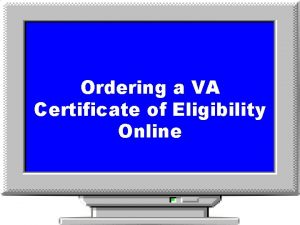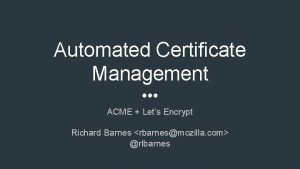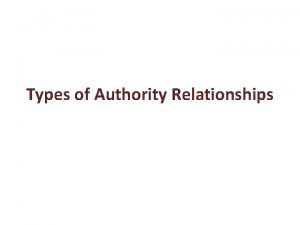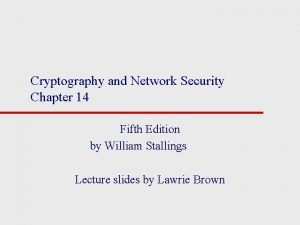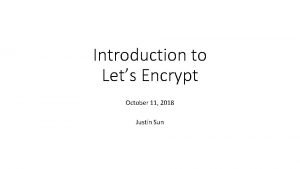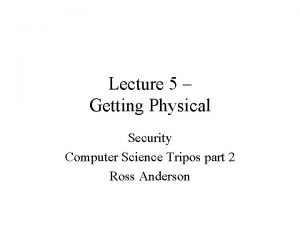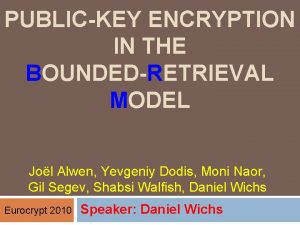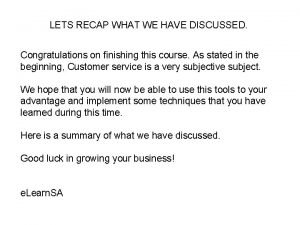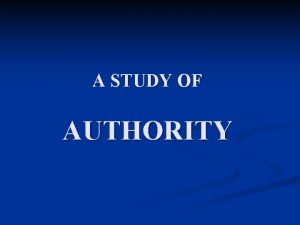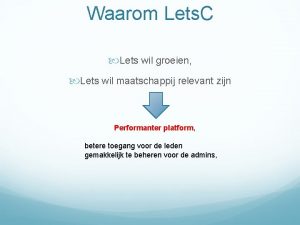Lets Encrypt An Automated Certificate Authority to Encrypt





















- Slides: 21

Let’s Encrypt: An Automated Certificate Authority to Encrypt the Entire Web Josh Aas et al. ACM CCS 2019 2020. 7. 14. Joonhee Lee jhlee 2019@mmlab. snu. ac. kr

Outline • Introduction • Motivation • ISRG & ACME • Implementation • Impact of Let’s Encrypt • Conclusion 2 / 21

Introduction • Low adaption of HTTPS • HTTPS is important for practically every Web request • As 2015, 55 -70% of browser page loads used plaintext HTTP • Major barrier to wider HTTPS adoption • Complicated, expensive, and error-prone deployment for server operators • Process: validation, key generation, issuance, installation, payment • Let’s Encrypt: A free and automated Certificate Authority (CA) • Automation: No manual steps, no human error, low cost-per-certificate • Free certificate: Eliminated financial burdens and payment friction 3 / 21

Certificate Cost and Marketplace • High prices for certificates • One-year single-domain certificate: $178 • Wildcard certificate: $766 • Limitation for lower-cost alternatives • Complex marketplace • Difficult for server operators to navigate • Bundled with additional services • Vulnerability assessment scans • Warranties covering losses by certificate error 4 / 21

Obtaining and Installing a Certificate • Difficult, manual, and tedious process of obtaining a certificate • • • Recognize that they need a certificate Navigate the confusing marketplace Generate a private key, and create a Certificate Signing Request (CSR) Perform the verification step required by the CA Configure their server with the certificate and the appropriate trust chain • Risk of security vulnerabilities through misconfiguration • Annual certificate renewals • Renewal lapse occurred for about 20% trusted certificates 5 / 21

CA Validation Practices • Several categories of validation defined by the CA/Browser Forum • Domain Validation (DV): The requestor has control over the domain • Organization Validation (OV): CAs verify public business registration document • Extended Validation (EV): More intensive checks of proper ownership • Negating security benefits of OV and EV • • OV and EV require manual verification Users do notice the distinction between levels Browsers have or will drop UI distinctions Let’s Encrypt offers only DV which can be automated 6 / 21

Internet Security Research Group (ISRG) • Merge of two simultaneous effort to build a fully automated CA • A. Halderman (University of Michigan) & P. Eckersely (Electronic Frontier Foundation): Developing a protocol for automatically issuing certificates • J. Aas & E. Rescorla (Mozilla): Creating a free and automated CA • Internet Security Research Group (ISRG) • • A nonprofit corporation formed in May 2013 The legal entity operating Let’s Encrypt No profit motive, no ownership, relatively high transparency, a public service Let’s Encrypt began providing service to public on December 2015 7 / 21

Budget and Fundraising • Large donations from technology companies • Donations and financial commitments from Akamai, Cisco, EFF, and Mozilla • Stable operating costs • • ISRG spent approximately $3 M in 2018 (Excl. in-kind contributions like hosting) CA operations are heavily automated Staffing is the largest category of expense Stable operating costs despite enormous growth in certificate issuance 8 / 21

Becoming a Trusted Issuer • Broad client deployment of new root CA takes long time • It takes years for a new CA of Google’s root program to be available on the majority of Android devices • ISRG tried to purchase an existing root, but never completed an acquisition • Cross-signed intermediate CA certificate • Already widely trusted CA can issue a cross-signed intermediate CA certificate • ISRG executed a long-term cross-signing agreement with Iden. Trust • ISRG’s own root certificate is widely deploying • Planning to change root from Iden. Trust to ISRG in July 2020 9 / 21

ACME Protocol • Automated Certificate Management Environment (ACME) protocol • Designed with scalable, automated issuance as a core goal • Published a final version as RFC 5555 by the IETF ACME working group • Interactions: Registration, validation, issuance, revocation • Registration: Account Management • Tracking which applicant is allowed to request issuance for which identifiers • The applicant registers a key-pair with some optional metadata • Authenticated by digital signatures, not by pre-shared secrets or passwords 10 / 21

ACME Protocol: Detailed Process 11 / 21

Validation Methods • Authorization and validation • Account holder completes challenges that validate control of the identifier • ACME supports commonly used and easily automated validation methods • Challenge types supported by Let’s Encrypt • HTTP challenge: CA-provided random value at a specific URL at the domain Required to be provisioned across all servers in load-balanced config • DNS challenge: CA-provided random value at a specific DNS record Only option for wildcard certificate to prove control over the DNS zone • TLS-ALPN challenge: CA-provided random value at self-signed certificate Allowing a TLS-terminating load balancer to issue a certificate 12 / 21

Certificate Issuance and Revocation • Certificate request and issuance • Order: a client’s request object for a certificate • No renewal: Requests a new certificate • Revocation is allowed to • The account that issued the certificate • Who can prove control of the identifiers • Who can control of the private key of the certificate Who encounters a leaked key can request automated revocation 13 / 21

Design of New CA Software • Boulder: Entirely different software to operate an automated CA • A new, open-source CA software stack that forms the core of Let’s Encrypt • Security Principles • • • Minimal logic: Verifying the code easily Minimal data: Reducing the potential harm from data breaches Full automation: Preventing human errors Functional isolation: Protecting critical components Operational isolation: Limiting risk of physical compromise Continuous availability: Redundant and parallel instances 14 / 21

Boulder Architecture • 3 main functions required of a CA in the modern Web PKI • Issuance of certificates, Submission to CT logs, Publication of OCSP 15 / 21

Client Ecosystem • No official client, but Certbot is most popular • Certbot automatically parses and modifies configuration files of Apache, Nginx, etc. • Automatic provisioning web servers • Several web servers can automatically provision Let’s Encrypt certificates (ex. Caddy) • Hosting and CDN providers • Providers can enable HTTPS for all of their sites without any user interaction • Small sites can easily migrate to HTTPS Necessary to transition the entire web to HTTPS 16 / 21

Impact of Let’s Encrypt • Fastest growing CA among Alexa Top 1 M sites • Increasing in market share to 35% (2019) • No sites in the Alexa Top 100 used a Let’s Encrypt certificate (2018) • 83% of top 100 sites use OV or EV certificates (Let’s Encrypt issues only DV) 17 / 21

Centralization of HTTPS • Hosting and CDN providers serves HTTPS automatically to users • Many of the networks with the most of Let’s Encrypt certificates are large cloud providers • 50% of names in certificates are located in just 10 ASes, 80% are in 100 ASes • Broader centralization of the web • ASes with the most Let’s Encrypt domains • Unified Layer: 34 M domains (27%) 18 / 21

New HTTPS Use Cases • Blog and hosting providers • Several large blog providers create a unique subdomain for each blog • Ex. 1. 3 M certificates issued for subdomains of home. blog • Io. T devices • Io. T manufacturers create a subdomain and certificate for each Io. T device • Ex. 875 k certificates issued for subdomains of keenetic. io • “Trusted” certificates to all servers and devices • Let’s Encrypt can issue trusted certificates to all web servers and Io. T devices with no charge 19 / 21

Success of Let’s Encrypt • Automation enables free certificates • Automation is the only mechanism for keeping per-certificate costs down • Free certificates make automation practical • Payment makes automation significantly less valuable • Gradual deployment is essential • Actual deployment of a universal system requires every client to change • Let’s Encrypt was abled to issue immediately valid certificates thanks to the cross-signed CA certificate • Deployed rapidly without asking both sides to change 20 / 21

Conclusion • Let’s Encrypt: A free, open, and automated HTTPS CA • New CA software system (Boulder) • Organization that operates it (ISRG) • IETF-standard protocol to automate certificate issuance (ACME) • Overcoming a major barrier to wider HTTPS adoption • Before: Complicate, expensive, and error-prone deployment of HTTPS • After: Fully automated certificate issuance at no charge • Designed to scale to the size of the entire web • Over 538 million certificates issued (2019) • HTTPS as the default web transport in the near future 21 / 21
 Automated certificate of eligibility
Automated certificate of eligibility Automated certificate management environment
Automated certificate management environment What is line authority
What is line authority Certificate authority (ca) vs key distribution centre (kdc)
Certificate authority (ca) vs key distribution centre (kdc) Encrypt
Encrypt Why johnny can't encrypt
Why johnny can't encrypt Encrypt
Encrypt Get ready for
Get ready for Lets see what you already know
Lets see what you already know The lets
The lets Let's have a quick recap
Let's have a quick recap Interactive football quiz
Interactive football quiz Practice task 1 guess what
Practice task 1 guess what Lets fight it together cyberbullying
Lets fight it together cyberbullying With words
With words Lets see what you already know
Lets see what you already know Let's play jeopardy
Let's play jeopardy Plan lets go
Plan lets go Describe the person in the picture
Describe the person in the picture Lets make things better slogan
Lets make things better slogan Lets see what you know
Lets see what you know Integer numbers
Integer numbers
